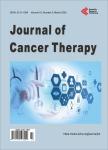The size of Metastasis in the Sentinel Node Is a Predictor of Additional Non-Sentinel Node Positivity
The size of Metastasis in the Sentinel Node Is a Predictor of Additional Non-Sentinel Node Positivity作者机构:Department of Pathology Loyola University Chicago Stritch School of Medicine Maywood USA Department of Preventative Medicine and Epidemiology Loyola University Chicago Stritch School of Medicine Maywood USA Department of Surgery Loyola University Chicago Stritch School of Medicine Maywood USA
出 版 物:《Journal of Cancer Therapy》 (癌症治疗(英文))
年 卷 期:2012年第3卷第5期
页 面:712-717页
学科分类:1002[医学-临床医学] 100214[医学-肿瘤学] 10[医学]
主 题:Sentinel Node Axillary Lymph Node Dissection (ALND)
摘 要:Background: The need for axillary lymph node dissection (ALND) when sentinel lymph nodes (SLN) contain micrometastasis is controversial. The purpose of this study was to determine if the size of tumor in the SLN corresponds with additional positive non-sentinel lymph nodes (non-SLN) in pT1 breast cancer. Methods: This retrospective review of 483 patients with pT1 breast cancer identified 96 patients with tumor positive SLN biopsies between June 1999 and February 2010. The size of SLN metastasis and the number of tumor positive non-SLN were recorded using AJCC criteria. Receiver operating characteristic analysis was used to discriminate the SLN size with the optimal sensitivity, specificity and likelihood ratios (LR) for additional positive non-SLN. Results: Among 96 patients with a tumor positive SLN, 41% (n = 39) had micrometastasis, and 59% (n = 57) had macrometastasis. A positive non-SLN was identified after ALND among 18% (n = 7 of 39) with micrometastasis compared with 39% (n = 22 of 57) with macrometastasis (p = 0.04). The size of the SLN metastasis and presence of additional tumor positive non-SLNs corresponds to a positive likelihood ratio of 1.1 for micrometastasis and 1.6 for macrometastasis (95%CI: 0.56 - 0.74). Conclusions: Increased size of tumor in SLN is associated with greater likelihood of non-SLN positivity and should be considered for more aggressive follow-up and therapy.



